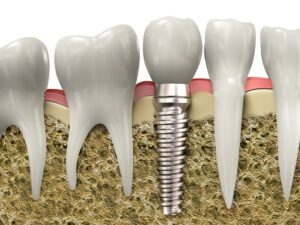 After losing a tooth or multiple teeth, it’s common for people to experience issues with gum recession and bone loss along the jaw. In simple terms, the loss of the tooth’s root structure from the jaw leads to the loss of bone density along that part of the jaw. The team at our Jackson practice sees this quite a bit.
After losing a tooth or multiple teeth, it’s common for people to experience issues with gum recession and bone loss along the jaw. In simple terms, the loss of the tooth’s root structure from the jaw leads to the loss of bone density along that part of the jaw. The team at our Jackson practice sees this quite a bit.
Bone loss can be especially bad when people are missing many teeth. The dental arch may be lacking in bone density, which could lead to issues with facial appearance around the lips and cheeks. This can also lead to problems getting dental implants to support bridges and dentures.
Bone Density and Issues with Implant Dentistry
When you lose bone density along the dental arch, it can have a significant impact on your ability to receive dental implants. In fact, oral surgeons will not be able to place any dental implants if there is not sufficient bone structure in place. Without proper bone density, the chances for successful dental implants treatment decrease significantly.
Thankfully, a process known as jawbone regeneration (bone grafting) can improve bone density and your ability to receive dental implants.
How Jawbone Regeneration Works
During jawbone regeneration, an oral surgeon places donor bone or artificial hard tissue along the dental arch. This hard tissue fuses with the original bone structure of the jaw and helps increase the density of the dental arch. Thanks to jawbone regeneration, patients will achieve normal bone density and be able to receive dental implants.
Ideal Candidates for Jawbone Regeneration
The ideal candidates for jawbone regeneration should be in good overall health so that an oral surgery procedure will not pose a risk to overall wellness. They should also have realistic expectations when it comes to the nature of the surgery and the side effects experienced after the surgery has been performed.
Donor Bone vs. Artificial Bone Grafts
As we noted above, the density of the jawbone can be improved using donor bone or artificial bone grafts. There are a few options for this:
- Autogeous Grafts – These bone grafts are taken from the donor’s own body.
- Allografts – Allografts are grafts that are taken from another human donor.
- Xenografts – These kinds of bone grafts are derived from animals, typically bovine sources.
- Synthetic Grafts – These artificial bone grafts may be created from different kinds of substances.
Since each patient has unique needs, the ideal type of bone graft can be discussed in greater detail with your oral surgeon.
Oral Surgery and Recovery
Following the jawbone regeneration procedure, patients will have a a recovery period that will last several weeks to a few months. The new bone tissue must join and grow with the existing jawbone in order for the procedure to be successful. Oral surgeons will provide their patients with detail instructions about the post-op process and what can be done to ensure proper and rapid recovery.
Realistic Expectations About Treatment Timelines
Ultimately, it’s important for patients to have realistic expectations when it comes to the treatment timeline for jawbone regeneration and implant dentistry. Undergoing the grafting procedure in addition to the dental implants procedure will add more time to the overall treatment process. Keep in mind that this added time is crucial for ensuring the best results possible.
During the consultation process, you will be able to discuss a treatment timeline for bone grafting and the osseointegration of the dental implant, and you may also discuss various alternatives to implant dentistry if you wish.
Learn More About Jawbone Regeneration
For more information about jawbone regeneration and how it can help you get dental implants, be sure to contact our team of cosmetic and restorative dentists today. Our team looks forward to discussing these matters with you in greater detail.